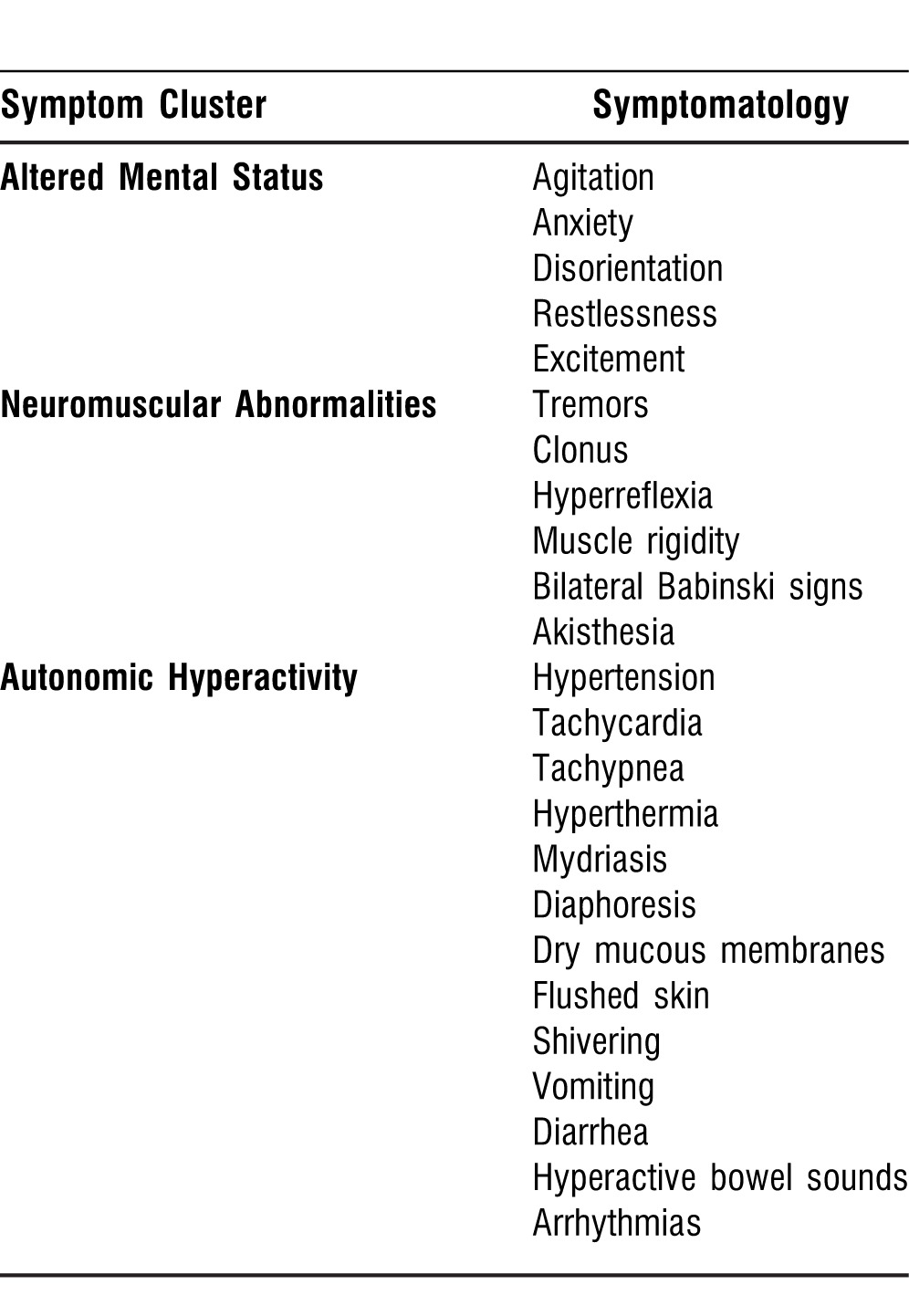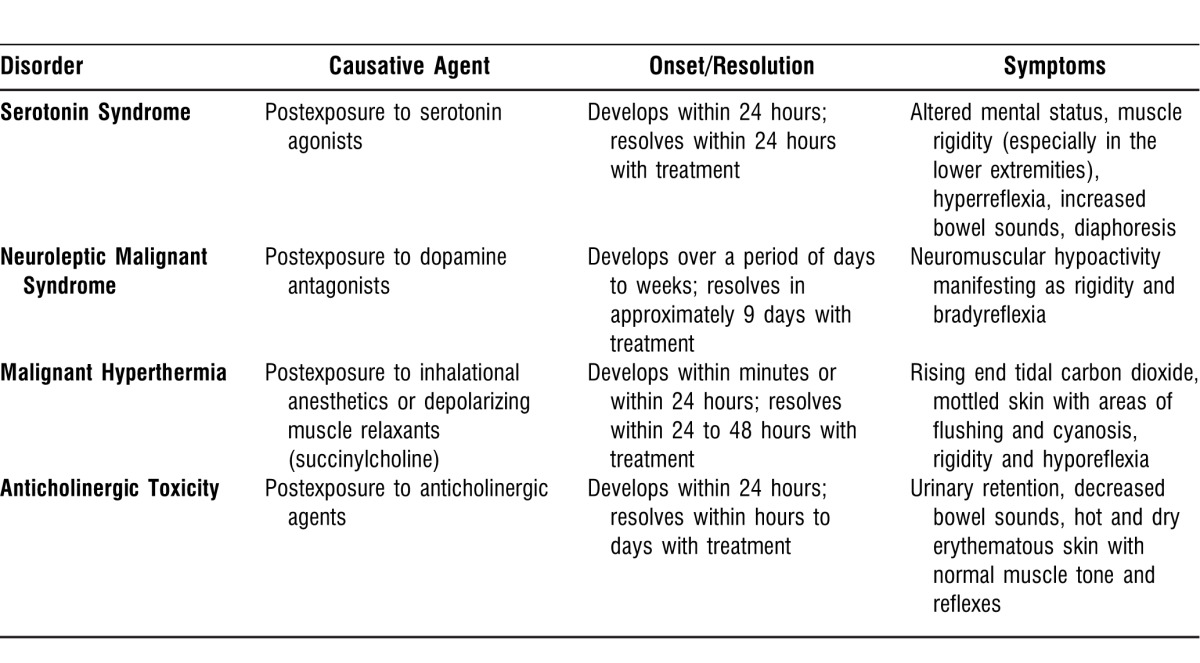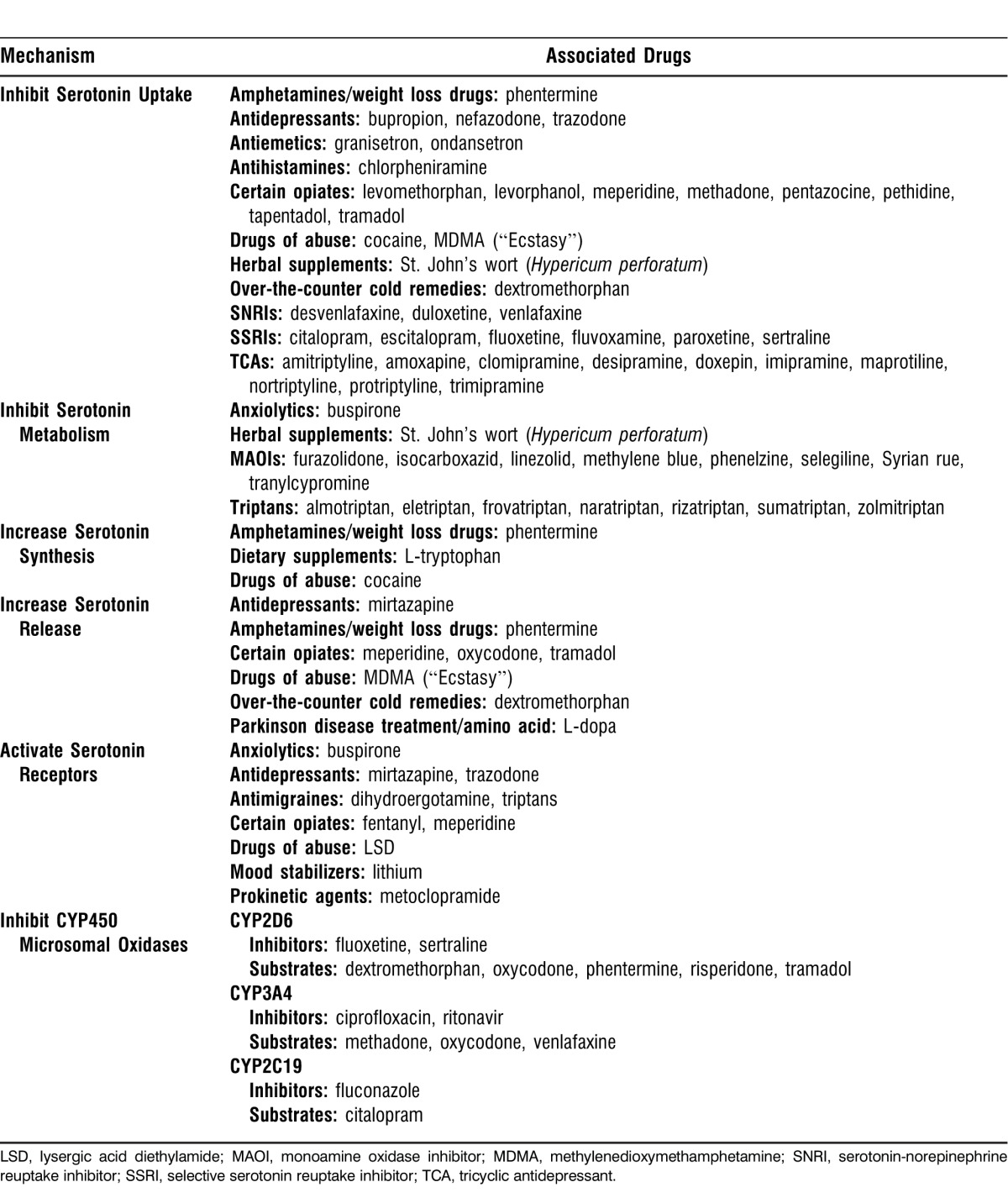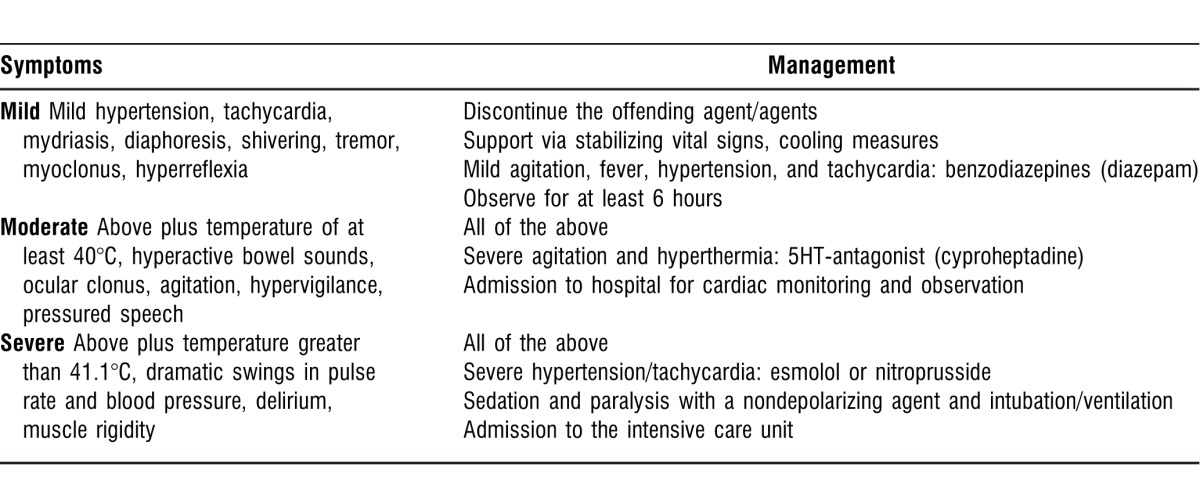Abstract
Background
Serotonin syndrome is a potentially life-threatening syndrome that is precipitated by the use of serotonergic drugs and overactivation of both the peripheral and central postsynaptic 5HT-1A and, most notably, 5HT-2A receptors. This syndrome consists of a combination of mental status changes, neuromuscular hyperactivity, and autonomic hyperactivity. Serotonin syndrome can occur via the therapeutic use of serotonergic drugs alone, an intentional overdose of serotonergic drugs, or classically, as a result of a complex drug interaction between two serotonergic drugs that work by different mechanisms. A multitude of drug combinations can result in serotonin syndrome.
Methods
This review describes the presentation and management of serotonin syndrome and discusses the drugs and interactions that can precipitate this syndrome with the goal of making physicians more alert and aware of this potentially fatal yet preventable syndrome.
Conclusion
Many commonly used medications have proven to be the culprits of serotonin syndrome. Proper education and awareness about serotonin syndrome will improve the accuracy of diagnosis and promote the institution of the appropriate treatment that may prevent significant morbidity and mortality.
Keywords: Drug toxicity, serotonin syndrome
INTRODUCTION
The actual incidence of serotonin syndrome is unknown. The number of actual cases is likely much greater than the actual reported cases. Serotonin syndrome is often not diagnosed secondary to mild symptoms that are attributed to being a general side effect of treatment, unawareness of the syndrome, varying diagnostic criteria, or misdiagnosis.1,2 The number of reported cases of serotonin syndrome has increased, probably secondary to the widespread use of these drugs and to the increasing awareness of this syndrome.1,2 Serotonin syndrome has been documented in all age groups.2
PRESENTATION
The presentation of serotonin syndrome is extremely variable, ranging from mild symptoms to a life-threatening syndrome. Many reports prefer to call this serotonin toxicity rather than syndrome due to its wide range of symptoms and toxicity.3 Symptoms usually begin within 24 hours of an increased dose of a serotonergic agent, the addition of another serotonergic agent to a drug regimen, or overdosing. Most patients will seek help at a hospital within 6 hours; however, patients with mild symptoms may have a more subacute or chronic presentation, as in the case by Houlihan.4
Patients will present with a triad of symptoms that range in severity (Table 1). In mild cases, the predominating features are mild hypertension and tachycardia, mydriasis, diaphoresis, shivering, tremor, myoclonus, and hyperreflexia. Patients with a mild syndrome are usually afebrile. Patients with a moderate syndrome usually have the above symptoms plus hyperthermia (40°C), hyperactive bowel sounds, horizontal ocular clonus, mild agitation, hypervigilance, and pressured speech. In severe cases, patients have all of the above symptoms plus hyperthermia greater than 41.1°C, dramatic swings in pulse rate and blood pressure, delirium, and muscle rigidity. Severe cases may result in complications, such as seizures, rhabdomyolysis, myoglobinuria, metabolic acidosis, renal failure, acute respiratory distress syndrome, respiratory failure, diffuse intravascular clotting, coma, and death.1,2 The symptoms of hyperreflexia, rigidity, and clonus tend to be more prominent in the lower extremities.1,2
Table 1.
Symptomatology Triad Associated With Serotonin Syndrome

Fluoxetine and its metabolite norfluoxetine have longer half-lives (1 week and 2.5 weeks, respectively) than other selective serotonin reuptake inhibitors (SSRIs) and can therefore precipitate this syndrome even if discontinued for up to 6 weeks before the patients begin taking another serotonergic agent. These drugs, along with irreversible monoamine oxidase inhibitors (MAOIs), can cause symptoms to persist for days to weeks even with treatment.1,2
DIAGNOSIS
Serotonin syndrome is a diagnosis of exclusion. No single diagnostic test can confirm this syndrome.2,4 The diagnostic gold standard for serotonin syndrome is diagnosis by a medical toxicologist.3 In a clinical setting, however, the suspicion of serotonin syndrome and diagnosis must occur rapidly so treatment can prevent the morbidity and mortality associated with this condition. Therefore, a diagnosis of serotonin syndrome is entirely clinical and is based on the history and physical examination along with history of the patient's use of a serotonergic drug. Important components of the history include prescription drug use, over-the-counter medication and dietary supplement use, illicit substance use, any recent changes in dosing, or the addition of new drugs to a drug regimen. The onset and description of symptoms and the presence of any comorbidities are of utmost importance. Certain comorbidities, such as depression and chronic pain, may alert the clinician to the use of drugs that can precipitate serotonin syndrome. Also, a higher incidence of serotonin syndrome has been reported in patients with end-stage renal disease who are on selective serotonin reuptake inhibitors (SSRIs) and hemodialysis. These patients are prone to developing serotonin toxicity, suggesting that this increased toxicity could be related to a decrease in renal functioning.5 An integral part of the physical examination for diagnosing serotonin syndrome is the neurological examination.6
Several diagnostic criteria have been proposed for serotonin syndrome. The most recent diagnostic criteria are the Hunter Serotonin Toxicity Criteria (HSTC) that have replaced the older Sternbach Criteria in an attempt to simplify the diagnosis. When compared to the gold standard of diagnosis by a medical toxicologist, the HSTC are more sensitive (84% versus 75%) and specific (97% versus 96%) than the Sternbach criteria. The HSTC include the use of a serotonergic agent plus 1 of the 5 following criteria: spontaneous clonus, inducible clonus plus agitation or diaphoresis, ocular clonus plus agitation or diaphoresis, tremor and hyperreflexia, hypertonia and a temperature above 38°C plus ocular or inducible clonus.3 Clonus and hyperreflexia are most important for the diagnosis; however, severe muscle rigidity may mask these symptoms. Prominent features of life-threatening cases include hyperthermia (>38.5°C), peripheral hypertonicity, and truncal rigidity because of the high risk of progression to respiratory failure.3 Some nonspecific laboratory abnormalities may be seen in serotonin syndrome: leukocytosis, low bicarbonate level, elevated creatinine level, and elevated transaminases. Serum serotonin concentrations do not correlate with the severity of this syndrome.1
The many differential diagnoses to consider when diagnosing serotonin syndrome include neuroleptic malignant syndrome (NMS), malignant hyperthermia, anticholinergic toxicity, serotonergic discontinuation syndrome, sympathomimetic drug intoxication, meningitis, encephalitis, heat stroke, and central hyperthermia. Some diagnoses may be distinguished from serotonin syndrome by the clinical features, medication usage, and time course. The distinguishing features of NMS, malignant hyperthermia, and anticholinergic toxicity are listed in Table 2.
Table 2.
Differentiating Serotonin Syndrome Among Common Presentations

MECHANISM
Serotonin syndrome and its spectrum of symptoms are a product of the overactivation of both the central and peripheral serotonin receptors as a result of high levels of serotonin. Serotonin (5-hydroxytryptamine [5-HT]) is formed from the decarboxylation and hydroxylation of tryptophan, which is then stored in vesicles and released into the synaptic cleft when stimulated. 5-HT is metabolized by monoamine oxidase-A (MAO-A) into 5-hydroxyindoleacetic acid. Serotonin can bind to at least 7 families of 5-HT receptors.2,7 No single receptor is responsible for the development of serotonin syndrome; however, several studies provide evidence that the 5HT-2A receptors are the most important receptors involved.2,8
Serotonin can act both peripherally and centrally. Peripheral serotonin is produced primarily in the enterochromaffin cells of the gastrointestinal (GI) tract. It functions to stimulate vasoconstriction, uterine contraction, bronchoconstriction, GI motility, and platelet aggregation. Central serotonin is present in the midline raphe nuclei of the brainstem from the midbrain to the medulla. It functions to inhibit excitatory neurotransmission and to modulate wakefulness, attention, affective behavior (anxiety and depression), sexual behavior, appetite, thermoregulation, motor tone, migraine, emesis, nociception, and aggression.2,9
In several animal studies, high levels of noradrenaline seen during the course of serotonin syndrome may also have contributed to the symptoms.8,10 N-methyl-D-aspartate (NMDA)-receptor antagonists, gamma-aminobutyric acid (GABA), and dopamine may also play a role in serotonin syndrome, but their impact is still unclear.10
The drugs that have been reported to cause serotonin syndrome and the mechanism of each are listed in Table 3. The mechanisms are as follows: inhibition of serotonin uptake, decreased serotonin metabolism, increased serotonin synthesis, increased serotonin release, and activation of serotonergic receptors. Another mechanism involves the inhibition of certain cytochrome P450 (CYP450) enzymes by the SSRIs themselves, including CYP2D6 and CYP3A4.11,12 This inhibition results in the accumulation of certain serotonergic drugs (venlafaxine, methadone, tramadol, oxycodone, risperidone, dextromethorphan, and phentermine) that are usually metabolized by these enzymes, creating an exacerbation loop in which the SSRI inhibits the metabolism of a certain drug, which in turn increases serotonergic activity. Several studies discuss the importance of this mechanism in the development of serotonin syndrome with the concomitant use of an SSRI with tramadol.13,14 Many drugs, in addition to SSRIs, can inhibit these enzymes, resulting in the accumulation of serotonergic drugs that are being used simultaneously. Ciprofloxacin has been reported to cause serotonin syndrome via its CYP3A4 inhibition.15 A case report of serotonin syndrome caused by the concomitant use of citalopram and fluconazole suggested that the inhibition of CYP2C19 by fluconazole resulted in the accumulation of its substrate citalopram.16 These studies show the importance of understanding CYP450 interactions in the development of serotonin syndrome. For an extensive list of the CYP enzymes and the drugs that are inhibitors, inducers, or substrates for each, refer to the CYP450 drug interactions document.17
Table 3.
Mechanisms of Serotonin Syndrome and the Drugs Associated with Each

The reported drug interactions that have caused serotonin syndrome continue to increase and include many different combinations of serotonergic drugs. Some of the reported drug combinations are listed in Table 4. The most well-known combination is an SSRI with an MAOI. However, the combination of any 2 serotonergic drugs can possibly precipitate this syndrome and therefore should be used sparingly or with great caution. Life-threatening cases tend to occur with the use of an irreversible MAOI or with combinations of serotonergic drugs rather than with just the use of an SSRI alone.2,3,18,19
Table 4.
Reported Drug Combinations Causing Serotonin Syndrome

Stanford et al claim that combining an SSRI with a serotonin-releasing agent actually reduces the risk of serotonin syndrome rather than increases it.18 The proposed mechanism is via the impaired reuptake and impaired retrotransport, which is caused by reuptake inhibitors. The combination of impaired reuptake and impaired retrotransport results in high levels of serotonin in the synapse without a subsequent uptake of serotonin into the cells to cause an effect.18 This theory is supported by a review by Silins et al of the use of MDMA and other serotonergic drugs.20 In contrast, the combination of an SSRI with an MAOI or a serotonin releaser with an MAOI does result in serotonin syndrome.18
A critical value of serotonin appears to be necessary for the development of serotonin syndrome.3,4 A case reported by Houlihan showed the development of serotonin syndrome when tramadol was added to a venlafaxine and mirtazapine regimen.4 This case report supports the idea that the development of serotonin syndrome is concentration dependent. Different patients present with serotonin syndrome at varying drug dosages and combinations, suggesting that the critical value is likely different for each individual and that individual variability probably plays a role in the development of serotonin syndrome. One example of individual variability includes possible genetic differences in the SERT gene, a serotonin transporter. An animal study by Fox and colleagues showed that SERT-deficient mice exhibit increased susceptibility to serotonin syndrome-like behavior when given serotonergic drugs.21 Other proposed mechanisms of individual variability include polymorphisms of CYP2D6 or of the 5HT-2A and 5HT-3B receptors.18
MANAGEMENT
The keys to management are discontinuing all serotonergic agents, providing supportive care via stabilizing vital signs, giving oxygen to keep oxygen saturation greater than 93%, administering intravenous fluids, providing continuous cardiac monitoring, sedating with benzodiazepines, and possibly administering serotonin antagonists. With treatment, serotonin syndrome usually resolves within 24 hours. Treatment for mild cases includes discontinuation of the serotonergic agent, support, sedation with benzodiazepines, and observation for at least 6 hours. Moderate cases can be treated as above with the addition of a serotonin antagonist and admission to the hospital for cardiac monitoring and observation. In severe, life-threatening cases, the patient should be treated as above with the addition of sedation, paralysis, and intubation/ventilation in the intensive care unit.1,2 Table 5 provides an overview of management based on symptom severity.
Table 5.
Management of Serotonin Syndrome

The management of mild hypertension and tachycardia includes benzodiazepines. Diazepam, a GABA-mimetic, has been studied the most and has been shown to blunt the hyperadrenergic symptoms of serotonin syndrome.2,9,10 Therefore, diazepam not only works to sedate the patient, but it can also correct mild hypertension and tachycardia and reduce fever.10 If a patient exhibits severe hypertension and tachycardia, short-acting esmolol or nitroprusside should be used. Long-acting agents such as propranolol should not be used because these agents can cause hypotension and can mask tachycardia. Masking tachycardia is undesirable because tachycardia can be used to follow treatment response and patient improvement.2,3 Additionally, propranolol is a 5HT-1A receptor antagonist, which did not help resolve serotonin syndrome in an animal study.8 If a patient presents with hypotension, which can commonly occur with the concomitant use of propranolol and MAOIs, the preferred treatment is a low dose of direct-acting sympathomimetics, including norepinephrine, epinephrine, and phenylephrine.2
If a patient still remains agitated after the use of benzodiazepines and stabilization of vital signs, serotonin antagonists can be administered; 5HT-2A receptor antagonists seem to be the most effective. Animal studies have shown that because of their 5HT-2A receptor antagonism, both cyproheptadine and chlorpromazine in high doses can be used to prevent hyperthermia and lethality in serotonin syndrome. Cyproheptadine is the more potent 5HT-2A receptor antagonist and therefore may be more effective than chlorpromazine.8 Several case reports have shown that cyproheptadine provides symptomatic relief in mild to moderate cases of serotonin syndrome, but its efficacy in severe cases has yet to be studied. Also, cyproheptadine does not shorten the time course of serotonin syndrome.22,23 The recommended dose of cyproheptadine is an initial dose of 12 mg, with the addition of 2 mg every 2 hours if symptoms persist. A maintenance dose of 8 mg should be used every 6 hours once the patient is stabilized.1,24 Chlorpromazine can cause severe orthostatic hypotension and therefore should not be used in patients who are already hypotensive.2 If a patient needs to be restrained, chemical restraint is preferred over physical restraint that can cause muscle contractions and lactic acidosis and worsen hyperthermia.2
Minimizing excess muscle activity and cooling measures can be used to treat hyperthermia. Antipyretics are not useful for the treatment of hyperthermia in serotonin syndrome because the high temperature is secondary to increased muscle activity and not due to a change in the hypothalamic temperature set point.2,9 For temperatures greater than 41.1°C, the patient should be sedated, paralyzed with a nondepolarizing agent such as vecuronium, and intubated. Succinylcholine should not be used because of the risk of hyperkalemia and possible worsening of rhabdomyolysis.1
Olanzapine and risperidone, atypical antipsychotics, have been paradoxically reported to both induce a serotonin syndrome and to treat this syndrome.9 A case report by Haslett and Kumar noted the development of serotonin syndrome after olanzapine was added to a drug regimen of lithium and citalopram. The mechanism is thought to be 5HT-2A and 5HT-3A receptor antagonism by these atypical antipsychotics, resulting in serotonin accumulation and cumulative activation of 5HT-1A receptors. This mechanism is also thought to be behind the serotonin syndrome caused by mirtazapine and fentanyl.25,26 On the other hand, olanzapine and risperidone have been reported to treat serotonin syndrome by way of their 5HT-2A receptor antagonism.27,28
Dantrolene, used as treatment for malignant hyperthermia, has not proven to be efficacious in the treatment of serotonin syndrome in animal models.8 Bromocriptine, a dopamine agonist used to treat neuroleptic malignant syndrome, may exacerbate serotonin syndrome by increasing serotonin levels.2 Neither of these agents plays a role in the treatment of serotonin syndrome.
CONCLUSION
The prognosis of serotonin syndrome is favorable if the patient is treated; therefore, physicians must be astute and aware of the possibility of this life-threatening syndrome. If the diagnosis is unclear, physicians should discontinue any serotonergic agents and start supportive care. There is no way to predict who will develop serotonin syndrome. The best way to prevent this syndrome is to avoid multidrug regimens and to discontinue any serotonergic agent before starting another. Furthermore, since new drug combinations that cause serotonin syndrome are continuously being discovered and serotonin syndrome occurs in each individual at different drug dosages and combinations, it is advisable that if 2 serotonergic drugs are used together, they be used with caution. If a patient is experiencing a mild form of serotonin syndrome but requires the medication, it is acceptable to assess the risks and benefits of the treatment and to decide whether the patient should remain on the drug. Patients with mild cases must be monitored closely for any worsening of symptoms and should be educated on the signs and symptoms of serotonin syndrome. Because of the widespread use of serotonergic drugs, clinicians must maintain a high clinical suspicion for serotonin syndrome; early recognition and treatment of serotonin syndrome can prevent significant morbidity and mortality.
Footnotes
The authors have no financial or proprietary interest in the subject matter of this article.
This article meets the Accreditation Council for Graduate Medical Education and the American Board of Medical Specialties Maintenance of Certification competencies for Patient Care and Medical Knowledge.
REFERENCES
- 1.Boyer EW, Traub SJ, Grayzel J. UpToDate. Waltham, MA: Serotonin syndrome. UpToDate; 2010. Accessed 28 September 2011. [Google Scholar]
- 2.Boyer EW, Shannon M. The serotonin syndrome. N Engl J Med. 2005 Mar 17;352(11):1112–1120. doi: 10.1056/NEJMra041867. Erratum in: N Engl J Med. 2007 Jun 7;356(23):2437. N Engl J Med. 2009 Oct 22;361(17):1714. [DOI] [PubMed] [Google Scholar]
- 3.Dunkley EJ, Isbister GK, Sibbritt D, Dawson AH, Whyte IM. The Hunter Serotonin Toxicity Criteria: simple and accurate diagnostic decision rules for serotonin toxicity. QJM. 2003 Sep;96(9):635–642. doi: 10.1093/qjmed/hcg109. [DOI] [PubMed] [Google Scholar]
- 4.Houlihan DJ. Serotonin syndrome resulting from coadministration of tramadol, venlafaxine, and mirtazapine. Ann Pharmacother. 2004 Mar;38(3):411–413. doi: 10.1345/aph.1D344. Epub 2004 Jan 23. [DOI] [PubMed] [Google Scholar]
- 5.Chander WP, Singh N, Mukhiya GK. Serotonin syndrome in maintenance haemodialysis patients following sertraline treatment for depression. J Indian Med Assoc. 2011 Jan;109(1):36–37. [PubMed] [Google Scholar]
- 6.Arora B, Kannikeswaran N. The serotonin syndrome - the need for physician's awareness. Int J Emerg Med. 2010 Aug 20;3(4):373–377. doi: 10.1007/s12245-010-0195-7. [DOI] [PMC free article] [PubMed] [Google Scholar]
- 7.Morgan GE, Mikhail MS, Murray MJ. Clinical Anesthesiology.4th ed. New York, NY: McGraw-Hill;; 2006. [Google Scholar]
- 8.Nisijima K, Yoshino T, Yui K, Katoh S. Potent serotonin (5-HT)(2A) receptor antagonists completely prevent the development of hyperthermia in an animal model of the 5-HT syndrome. Brain Res. 2001 Jan 26;890(1):23–31. doi: 10.1016/s0006-8993(00)03020-1. [DOI] [PubMed] [Google Scholar]
- 9.Dvir Y, Smallwood P. Serotonin syndrome: a complex but easily avoidable condition. Gen Hosp Psychiatry. 2008 May-Jun;30(3):284–287. doi: 10.1016/j.genhosppsych.2007.09.007. [DOI] [PubMed] [Google Scholar]
- 10.Nisijima K, Shioda K, Yoshino T, Takano K, Kato S. Diazepam and chlormethiazole attenuate the development of hyperthermia in an animal model of the serotonin syndrome. Neurochem Int. 2003 Jul;43(2):155–164. doi: 10.1016/s0197-0186(02)00213-9. [DOI] [PubMed] [Google Scholar]
- 11.Hardman JG, Limbird LE, Molinoff PB, Ruddon RW, Gilman AG. Goodman and Gilman's -The Pharmacological Basis of Therapeutics. 9th ed. New York, NY: McGraw Hill;; 1996. [Google Scholar]
- 12.Mitchell PB. Drug interactions of clinical significance with selective serotonin reuptake inhibitors. Drug Saf. 1997 Dec;17(6):390–406. doi: 10.2165/00002018-199717060-00005. [DOI] [PubMed] [Google Scholar]
- 13.Lange-Asschenfeldt C, Weigmann H, Hiemke C, Mann K. Serotonin syndrome as a result of fluoxetine in a patient with tramadol abuse: plasma level-correlated symptomatology. J Clin Psychopharmacol. 2002 Aug;22(4):440–441. doi: 10.1097/00004714-200208000-00022. [DOI] [PubMed] [Google Scholar]
- 14.Mason BJ, Blackburn KH. Possible serotonin syndrome associated with tramadol and sertraline coadministration. Ann Pharmacother. 1997 Feb;31(2):175–177. doi: 10.1177/106002809703100208. [DOI] [PubMed] [Google Scholar]
- 15.Lee J, Franz L, Goforth HW. Serotonin syndrome in a chronic-pain patient receiving concurrent methadone, ciprofloxacin, and venlafaxine. Psychosomatics. 2009 Nov-Dec;50(6):638–639. doi: 10.1176/appi.psy.50.6.638. [DOI] [PubMed] [Google Scholar]
- 16.Levin TT, Cortes-Ladino A, Weiss M, Palomba ML. Life-threatening serotonin toxicity due to a citalopram-fluconazole drug interaction: case reports and discussion. Gen Hosp Psychiatry. 2008 Jul-Aug;30(4):372–377. doi: 10.1016/j.genhosppsych.2008.03.008. [DOI] [PubMed] [Google Scholar]
- 17.Cytochrome P450 drug interactions. Pharmacist's Letter/Prescriber's Letter. 2006;22(2) 220233. (Full update October 2009) [Google Scholar]
- 18.Stanford SC, Stanford BJ, Gillman PK. Risk of severe serotonin toxicity following co-administration of methylene blue and serotonin reuptake inhibitors: an update on a case report of post-operative delirium. J Psychopharmacol. 2010 Oct;24(10):1433–1438. doi: 10.1177/0269881109105450. Epub 2009 May 7. [DOI] [PubMed] [Google Scholar]
- 19.Isbister GK, Bowe SJ, Dawson A, Whyte IM. Relative toxicity of selective serotonin reuptake inhibitors (SSRIs) in overdose. J Toxicol Clin Toxicol. 2004;42(3):277–285. doi: 10.1081/clt-120037428. [DOI] [PubMed] [Google Scholar]
- 20.Silins E, Copeland J, Dillon P. Qualitative review of serotonin syndrome, ecstasy (MDMA) and the use of other serotonergic substances: hierarchy of risk. Aust N Z J Psychiatry. 2007 Aug;41(8):649–655. doi: 10.1080/00048670701449237. [DOI] [PubMed] [Google Scholar]
- 21.Fox MA, Jensen CL, Gallagher PS, Murphy DL. Receptor mediation of exaggerated responses to serotonin-enhancing drugs in serotonin transporter (SERT)-deficient mice. Neuropharmacology. 2007 Oct;53(5):643–656. doi: 10.1016/j.neuropharm.2007.07.009. Epub 2007 Jul 27. [DOI] [PubMed] [Google Scholar]
- 22.Graudins A, Stearman A, Chan B. Treatment of the serotonin syndrome with cyproheptadine. J Emerg Med. 1998 Jul-Aug;16(4):615–619. doi: 10.1016/s0736-4679(98)00057-2. [DOI] [PubMed] [Google Scholar]
- 23.McDaniel WW. Serotonin syndrome: early management with cyproheptadine. Ann Pharmacother. 2001 Jul-Aug;35((7-8)):870–873. doi: 10.1345/aph.10203. [DOI] [PubMed] [Google Scholar]
- 24.Ables AZ, Nagubilli R. Prevention, recognition, and management of serotonin syndrome. Am Fam Physician. 2010 May 1;81(9):1139–1142. [PubMed] [Google Scholar]
- 25.Haslett CD, Kumar S. Can olanzapine be implicated in causing serotonin syndrome? Psychiatry Clin Neurosci. 2002 Oct;56(5):533–535. doi: 10.1046/j.1440-1819.2002.01050.x. [DOI] [PubMed] [Google Scholar]
- 26.Hamilton S, Malone K. Serotonin syndrome during treatment with paroxetine and risperidone. J Clin Psychopharmacol. 2000 Feb;20(1):103–105. doi: 10.1097/00004714-200002000-00020. [DOI] [PubMed] [Google Scholar]
- 27.Boddy R, Ali R, Dowsett R. Use of sublingual olanzapine in serotonin syndrome [Abstract] J Toxicol Clin Toxicol. 2004;42(5):725. [Google Scholar]
- 28.Nisijima K, Yoshino T, Ishiguro T. Risperidone counteracts lethality in an animal model of the serotonin syndrome. Psychopharmacology (Berl) 2000 May;150(1):9–14. doi: 10.1007/s002130000397. [DOI] [PubMed] [Google Scholar]


